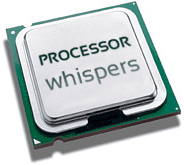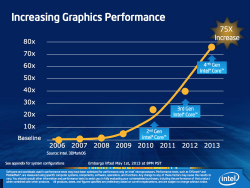Processor Whispers: Of new chips and old acquaintances
 by Andreas Stiller
by Andreas Stiller
In the wake of ARM and the new Silvermont Atom, old benchmarks see a return to popularity. Familiar faces from within the company take over the reigns at Intel and there is news about Haswell.
Those were the days: when Intel's former chief technologist, Pat Gelsinger, clearly communicated what he thought about the competition with his password "I hate AMD", and when Intel still compared explicitly named competitor systems (like the Opteron 285 2.8GHz, socket F) with their own systems using clear-cut benchmarks (such as matrix multiplication) on the IDF stage. Well, okay, the Opteron 285 with 2.8 GHz for the socket F didn't really exist – Intel probably meant the Opteron 2220 – but that was just a minor faux pas. And nowadays? Nowadays new systems are pitted against comp1, comp2, comp3, which stand for some unidentified competitor systems – that's what Intel Fellow Kuttanna and his boss Dadi Perlmutter did just now when presenting the new Atom architecture code-named Silvermont.
On top of that, the benchmarks employed for putting the new Atoms through their paces are an ill-defined, colourful mix of various classics, among them the totally outdated benchmark suite SPEC CPU2000. This suite was pulled off the market by SPEC no less than six years ago, so there are no current submissions, but only a large number of values, for the various architectures, prowling around the internet, often only relative to each other and without any consideration for base or peak or the number of threads used and also without any hint as to trivialities like compiler, operating system or configuration ... The ARM open source community Linaro has prepared SPECint_2000 for ARM systems – but, by default, only uses the training dataset, not the reference dataset, so caution is advised.

![]() No experiments. As tradition dictates, former COO Brian Krzanich has inherited the throne at Intel. The previous head of software, Renée James, now holds the position of president.
No experiments. As tradition dictates, former COO Brian Krzanich has inherited the throne at Intel. The previous head of software, Renée James, now holds the position of president.
Source: Intel
At the last Techcon, in October 2012, ARM's head of development, Mike Filippo, showed a diagram – for a few seconds, during the presentation of the 64-bit Cortex A57 code-named Atlas – with SPECint_2000 values for the Cortex A57 with 1.7GHz in comparison to the Cortex A15 (1.5GHz), A9 (1.4GHz), and Atom N570 (1.66GHz). His emulation results put the Cortex A57 at a SPECint-2000 value of 1250 – the same as once a Pentium 4 with 3.2GHz. According to data provided by NVIDIA, the Tegra 4 with 1.9GHz gets very close to this with 1168 SPECint_2000. With some effort – using lots of inter-comparisons – it's now possible to make a rough guess at the performance of the Atom Clovertrail Z2580 in full turbo mode with 2GHz: 670 SPECint_2000.
Intel reports that, as for single-thread performance, the new Atom Silvermont is twice as fast, which would place it slightly ahead of ARM's 64-bit competitor. But then, the latter hasn't arrived yet. It's scheduled for next year, initially to be manufactured in the 28nm process at TSMC. Soon afterwards, the 20nm versions will be due, which, with a clock speed of up to 2.2GHz, should exceed 1600 SPECint_2000.
One could now take a look at it from the perspective of multithreading, but as the data available on this topic is even more inaccurate, I shall pass on it for now. Besides, with Silvermont, Intel has moved on to weight the performance values with the power consumption. That's totally reasonable, but here also you have to take care, because Intel has meanwhile switched from using the TDP value to using the SDP (scenario design power) value. Hopefully, Intel's benchmarkers have taken that into account with the competition as well ...
Competition swap
In this arena, Intel doesn't even count AMD, with its Kabini and Temash processors, as competition any more. At the end of April, there were rumours that Intel might take over AMD – since then, AMD's share price has almost doubled. With ARM as the new competitor, Intel wouldn't have to worry about getting into conflict with the American anti-trust laws over acquiring AMD. In any case, the relationship with AMD is much more relaxed now than it was at the time of the previously mentioned IDF in 2006. A good example for this are the new Intel compilers V13, whose OpenMP doesn't discriminate against AMD processors any more. Although they still complain that the AMD processors don't support the CPUID entry for the topology (index 11), they do diligently set the processor affinities. Still, the AMD processors remain excluded from some of the higher honours of the Math Kernel Library (MKL), among them Intel's highly optimised Linpack benchmark.

![]() In the past, Intel's graphics were frequently laughed at, but now they are gaining pace.
In the past, Intel's graphics were frequently laughed at, but now they are gaining pace.
Source: Intel
Naturally, Intel's V13 compilers have already prepared everything for Haswell, including AVX2, FMA and transactional memory. In the meantime, Intel has released some more details about Haswell's graphics, in particular the official names. The high-end line will be called Iris with the Iris Pro 5200 at the top, which, until now, had been shown as GT3e on the roadmaps. The e stands for the 128MB of EDRAM, mentioned in the last Processor Whispers, which can be accessed by both CPU and GPU. A Core i7-4990HQ with Iris Pro 5200 (TDP 47 watts) is supposed to deliver roughly twice the graphics performance of a current Core i7-3840K (45 watts) with IGP Intel HD 4000.
In China, some Haswell systems have reportedly already become available for purchase. And in Japan, NEC presented its Haswell-equipped notebook LaVie, revealing some details about the processor. The reported USB 3.0 issue the processor is suffering from is not causing any real concerns. It only affects one USB controller type in USB 3.0 sticks and, at most, will require the chip to be logged in again after waking up from the S3 sleep mode.
Here in Europe, we will probably have to wait until Computex at the start of June for Haswell systems. Who knows, maybe Intel's new boss, the former COO Brian Krzanich, will use the opportunity to officially introduce himself – and the new Haswell generation.
(djwm)




![Kernel Log: Coming in 3.10 (Part 3) [--] Infrastructure](/imgs/43/1/0/4/2/6/7/2/comingin310_4_kicker-4977194bfb0de0d7.png)

![Kernel Log: Coming in 3.10 (Part 3) [--] Infrastructure](/imgs/43/1/0/4/2/3/2/3/comingin310_3_kicker-151cd7b9e9660f05.png)












